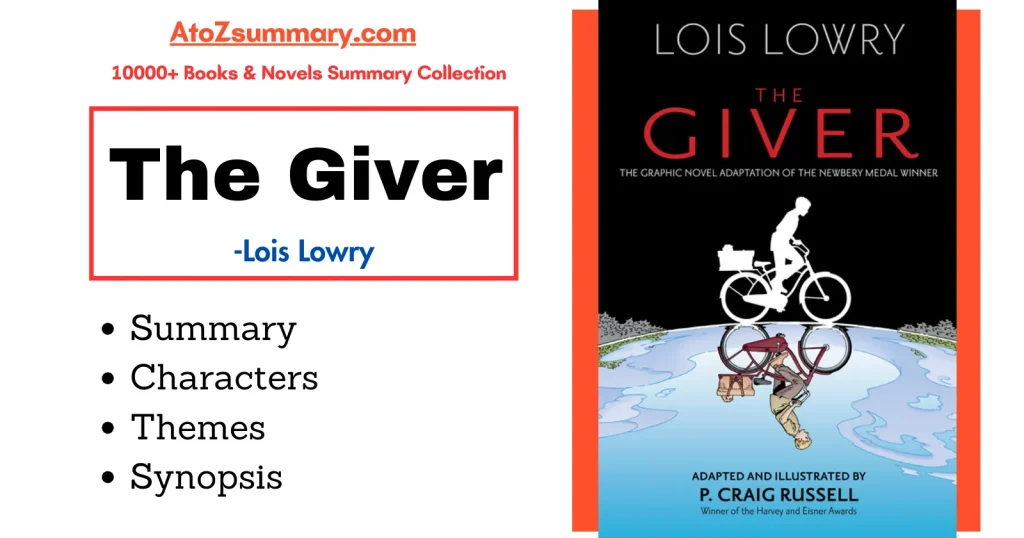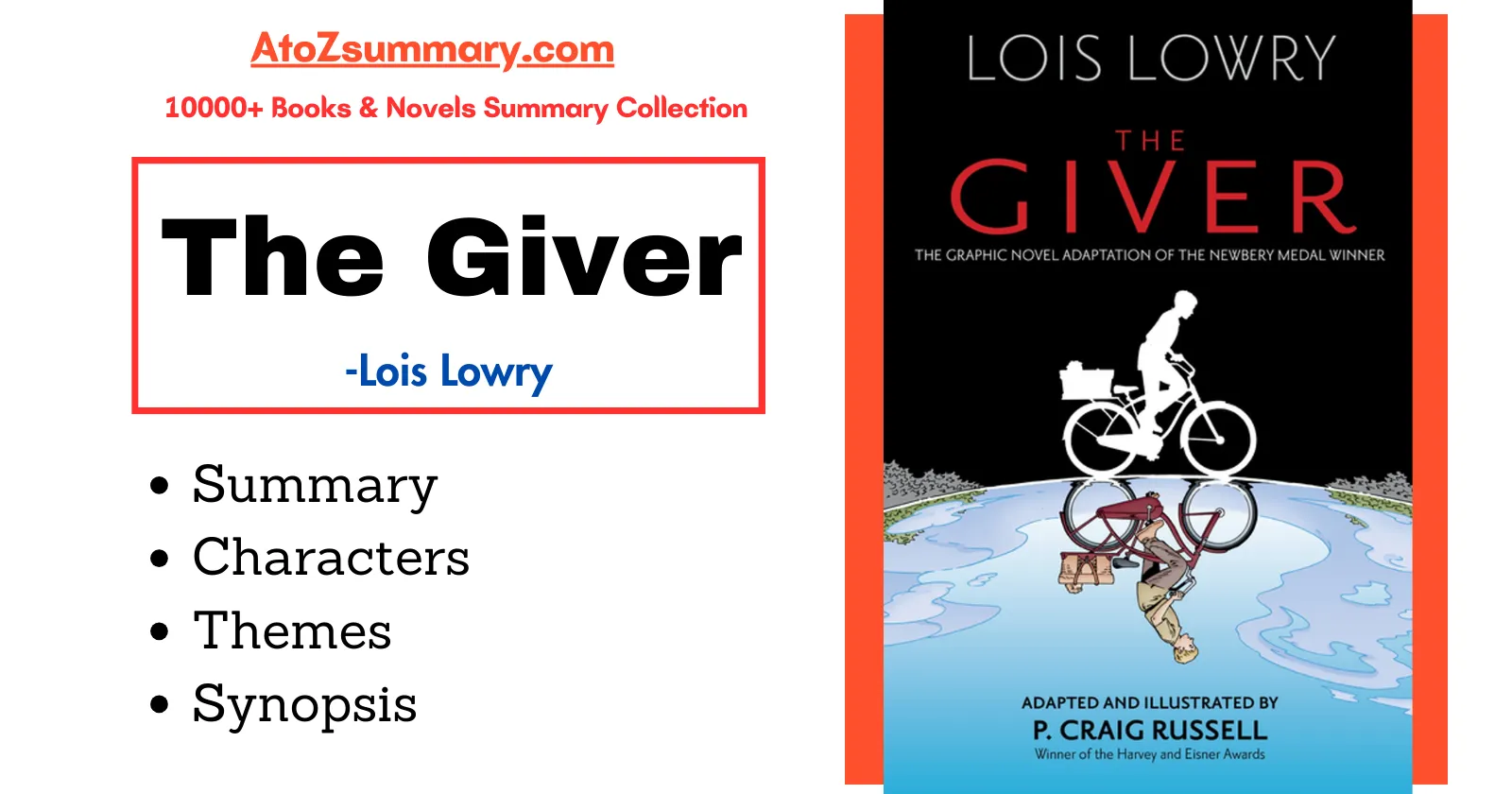
About the Novel-The Giver
| Title | The Giver |
| Author | Lois Lowry |
| Publisher | Houghton Mifflin |
| Publication Year | 1993 |
| No. of pages | 179 pages |
| Language | English |
| Genre | Dystopian, Science Fiction |
| Setting | A highly controlled, seemingly perfect future society |
Characters
The main characters of “The Giver” by Lois Lowry are:
- Jonas – The main character and the Receiver of Memory. He’s a young boy chosen to learn about the past.
- The Giver – An older man who holds all the memories of the past. He teaches Jonas about the world’s history and emotions.
- The Community Elders – The leaders of the society who make important decisions and control everyone’s lives.
Themes
The themes of “The Giver” by Lois Lowry are:
- Individuality – The novel explores how important it is to be yourself and make your own choices.
- Memories – It shows that memories, both good and bad, shape who we are and are essential for understanding life.
- Conformity vs. Freedom – It raises questions about whether it’s better to follow the rules of a strict society or to have the freedom to make your own choices.
- Emotions – The story highlights the value of feeling and expressing emotions, even if they can be painful.
- The Unknown – It delves into the fear and curiosity about the unknown and what lies beyond a controlled society.
- Truth and Deception – The novel explores how a society can hide the truth to maintain control and how discovering the truth can lead to change.
- Human Experience – It emphasizes the significance of experiencing life fully, with all its ups and downs.
Synopsis
“The Giver” is about a boy named Jonas who lives in a seemingly perfect, controlled society where emotions and individuality are suppressed.
When Jonas is chosen to be the Receiver of Memory, he starts learning about the world’s past, discovering both its pain and beauty. As he gains these memories, he begins to question his society’s values.
Eventually, Jonas faces a crucial choice that will change not only his life but also the destiny of his community. The book explores themes like memory, freedom, and the importance of human emotions.
Watch Full Novel Summary of “The Giver” on Yotube
Summary
The Giver is told from the perspective of Jonas, a 12-year-old child who lives in a dystopian society where all suffering, fear, violence, and hatred have been eradicated. Since everyone essentially shares the same appearance and behavior, there is little discrimination and very little competitiveness. Everyone is always courteous. Society has also done away with choice; starting at the age of twelve, each person in the community is given a job based on their skills and interests. Every marriage is given exactly two offspring apiece, and citizens can apply for and be allocated compatible spouses.
The children spend their first year at a nurturing center alongside other newborns, or “new children,” born that year. They are born to Birthmothers who never see them. Family units disintegrate as children reach adulthood, and people live with Childless people until they are too elderly to participate in society. They then receive care for the remainder of their lives in the House of the Old before being “released” back into society. The majority of people believe that following release, imperfect newborns and contented elders are welcomed into the great expanse of Elsewhere that surrounds the communities, even though the release is, in the community, always portrayed as death. People who disobey the law or don’t behave following society’s norms are also freed, however, in their circumstances, it is a cause for tremendous shame. Everything is arranged and prepared to make living as comfortable and enjoyable as possible.
Jonas resides with his mother, who works for the Department of Justice, his father, a new child nurturer, and his sister Lily, who is seven years old. He is anxious about receiving his formal Assignment as a new adult member of the society at the impending Ceremony of Twelve at the start of the book. Although he likes helping in many occupations, he does not have a certain professional preference. Although he is a model citizen and student, Jonas stands out because he has pale eyes, which are rare for his culture, and he has exceptional skills of awareness. When he stares at something, it may “change” sometimes.
Unbeknownst to him at the time, only he in his society can see bursts of color; for everybody else, the world is as devoid of color as it is of suffering, starvation, and annoyance.
Jonas receives the incredibly prestigious assignment of Receiver of Memory during the Ceremony of the Twelve. The only guardian of the community’s collective memory is the Receiver. The community abandoned all memories of pain, war, and emotion when it transitioned to Sameness, its generally painless, warless, and emotionless state of tranquillity and harmony, although the memories did not completely vanish. Even though only the Receiver can endure the suffering, someone must maintain it for the community to avoid repeating the errors of the past. The present Receiver, a wise old man who instructs Jonas to refer to him as the Giver, gives Jonas the memories of the past—both good and evil.
The Giver places his hands on Jonas’ exposed back to transmit memories. His earliest recollection is of a thrilling sled trip. Jonas discovers how monotonous and meaningless life in his village is when he gets memories from the Giver, including recollections of joy and anguish, vivid colors, terrible cold, and warm sun. Jonas hopes he can share the depth and importance that the memories provide to his life with the people he cares about.
However, the residents of Jonas’s town have given up their ability to love him back or feel intense enthusiasm for anything in return for their calm existence. Since they have never seen true grief, they are likewise unable to understand true joy, making the lives of individual people appear less significant in their eyes. Additionally, nobody in Jonas’ neighborhood has ever decided on their own. The Giver, who has had the same feelings about the people in his town for a long time, supports Jonas when he expresses increasing frustration with them. The two became extremely close, much as a grandpa and a granddaughter could have in the times before to Sameness when relatives maintained touch long after their children had grown up.
Jonas is assisting his family in caring for Gabriel, a problematic newborn who struggles to sleep through the night at the Nurturing Center, in the meanwhile. Every night, Jonas reads Gabriel’s calming memories to put him to sleep. As time goes on, he starts to form a bond with Gabriel that reflects the ones he has with his own family. The Giver tells Jonas that liberation is the same as death when Gabriel is in danger of being freed. The Giver is moved by Jonas’s fury and terror at this discovery and decides to assist him in coming up with a strategy to drastically alter the community.
Jonas hears from The Giver about the young woman who was chosen to be the new Receiver 10 years prior. Although she was the Giver’s biological daughter, the melancholy of some of the memories had been overwhelming for her, and she had requested to be freed. When she passed away, all of the memories she had amassed were released into the neighborhood, and the residents were unable to cope with the unexpected onslaught of feelings and emotions. The Giver and Jonas have a strategy for Jonas’s escape from the neighborhood and actual entry into Elsewhere. Once he has accomplished that, his greater collection of memories will scatter, and the Giver will assist the neighborhood in adjusting to the fresh emotions and ideas, forever altering society.
When his father informs Jonas that Gabriel will be released the next day, he is compelled to go sooner than anticipated. Jonas borrows his father’s bicycle and some food to travel to Elsewhere to save Gabriel. He gradually moves into a colorful, animal-filled, and changing-weather world, along with hunger, peril, and tiredness. Jonas and Gabriel go for a very long time, dodging search planes, until a lot of snow makes riding a bike difficult.
FAQs
What happened in the story The Giver?
In “The Giver,” a boy named Jonas lives in a controlled society where emotions and choices are suppressed. He’s chosen to be the Receiver of Memory, tasked with holding the memories of the past. As he learns about the world’s pain and beauty, he rebels against the society’s rules, eventually making a choice that changes everything.
What is the main point of The Giver?
The main point of “The Giver” is to show the importance of individuality, emotions, and memories in a society that suppresses them, and to explore the consequences of such control on human life.
Why did Jonas run away in The Giver?
Jonas ran away in “The Giver” because he wanted to escape the oppressive and controlled society that suppressed emotions, choices, and individuality, and he wanted to protect the baby Gabriel from being “released” (euthanized).
Why is The Giver an important story?
“The Giver” is important because it explores themes like the value of individuality, memory, and the consequences of a controlled society. It makes us question the trade-offs between safety and freedom, prompting us to think about the importance of human emotions and experiences.
How did The Giver end?
In the end, Jonas escapes the controlled society with a baby named Gabriel, seeking a better life and freedom from their restrictive world.
About the Author-Lois Lowry

| Full Name | Lois Lowry |
| Date of Birth | March 20, 1937 |
| Place of Birth | Honolulu, Hawaii |
| Nationality | American |
| Genre | Young Adult Fiction, Children’s Literature |
| Notable Works | – The Giver – Gathering Blue – Messenger |
| Website | Official Website |










![The Catcher In The Rye Summary, Themes & Characters [by J. D. Salinger] The Catcher In The Rye Summary, Themes & Characters [by J. D. Salinger]](https://atozsummary.com/wp-content/uploads/2023/06/The-Catcher-In-The-Rye-Summary-Themes-Characters-by-J.-D.-Salinger.webp)
